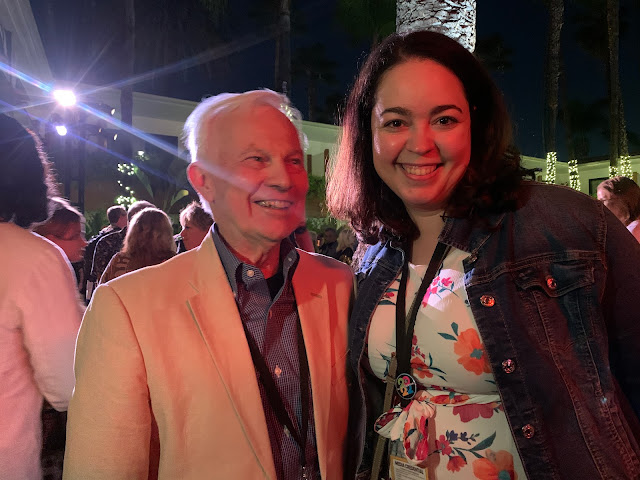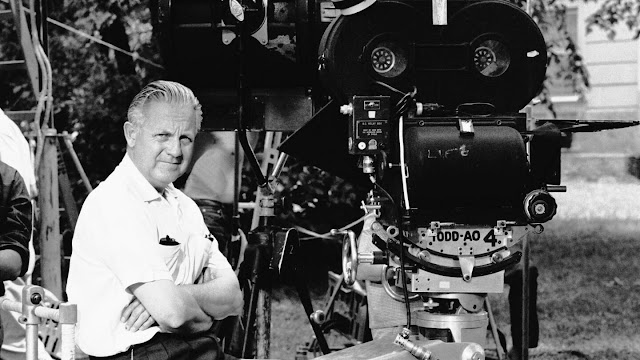 |
| Sloan De Forest. Photo credit: Manoah Bowman |
I've had the privilege of interviewing
Sloan De Forest, author of
Must See Sci-Fi: 50 Movies That are Out of This World (TCM/Running Press). She's an actress, writer and film historian and has written about film for Sony, Time Warner Cable, the Mary Pickford Foundation, and Bright Lights Film Journal. She's contributed essays to the books
Natalie Wood: Reflections on a Legendary Life and
Grace Kelly: Hollywood Dream Girl.
I'll be posting my review of her book (spoiler alert, it's rocking my world right now) and hosting a giveaway later this week. In the meantime, enjoy the interview:
Raquel Stecher: Tell us about your background as a film historian and your connection to old Hollywood.
Sloan De Forest: I took the circuitous route to become a film historian. I started as an actor and aspiring screenwriter. I did take some acting classes, but I mostly learned to act from watching those timeless performances by the likes of Katharine Hepburn, Cary Grant, Greta Garbo, Carole Lombard, and others. Turner Classic Movies was my college major! So I fell in love with classic film on my own before discovering it’s in my blood – my great-great uncle was Lee De Forest, who invented the sound-on-film process for talking pictures in 1923. He was the first to capture the voices of Elsa Lanchester, Una Merkel, and others on film, and provided a music soundtrack to Pola Negri’s first Hollywood film. That was an exciting connection to discover.
 |
| Lee De Forest |
Stecher: How did you first fall in love with the science fiction genre?
De Forest: It may have started the summer I turned 11, when I was visiting my grandparents in the country and there was nothing to do but watch old movies on television. I saw
The Blob and the 1958 version of
The Fly, which had a real impact on me. I also discovered old Twilight Zone episodes that summer. I didn’t consciously realize that I was falling in love with sci-fi, but those images stayed in my mind. Then in the '90s, Mystery Science Theater 3000 was my gateway into Ed Wood, then into Roger Corman, which led me to classics like
Forbidden Planet. I think because of their outrageous production design and costumes,
Forbidden Planet and
Barbarella were the sci-fis that fascinated me as a teenager. Well, those and
Plan 9 from Outer Space.
Stecher: How did you come to work on Must See Sci-Fi?
De Forest: As a first-time author, I was incredibly lucky. Fellow TCM author Manoah Bowman is someone I had met through a mutual friend. He knew I was a writer, editor, and Natalie Wood fan, so he hired me to contribute to his 2016 book
Natalie Wood: Reflections on a Legendary Life. From there, I had a foot in the door to write my own TCM book. It just so happened they were looking for someone to write a must-see guide for science fiction, and so it worked out perfectly.
Stecher: How did you curate the list of 50 science fiction movies for the book?
De Forest: With great difficulty! But seriously. There was quite a bit of friendly back-and-forth between me and TCM before settling on a final 50. Ultimately, you’re never going to please everyone with this kind of book, so it’s somewhat subjective. We wanted to include the most memorable, the most groundbreaking, and the most impactful films of the genre and I believe we succeeded. Even if we left out some that are great movies, I tried to include them in the Keep Watching section or at least mention them in the text. So I actually discuss A LOT more than 50 movies.
Stecher: What kind of research did you do for the book?
De Forest: I watched and re-watched all the films, of course, even if I had already seen them many times. Next I read books about the making of the films when I could, and went to the Margaret Herrick Library in Beverly Hills, which is a great resource for production files, press books, and clippings. I kept my online research to a minimum because—even though there are some great and highly reputable websites—I tried to avoid repeating all the same old information available on Wikipedia. But with some of these classics like
Star Wars for example, repetition is impossible to avoid, because everything there is to know is already common internet knowledge. But I tried to dig deep—in old newspaper archives, for example—and find a few nuggets.
Stecher: Which movies did you leave out that you wish could have made the cut?
De Forest: I wanted to include a couple of my personal favorites, like
Galaxy Quest and
Sky Captain and the World of Tomorrow. I don’t think
Sky Captain is strictly considered science fiction, but I am fascinated by that movie. There’s nothing else like it. As for
Galaxy Quest, I’m not sure why it didn’t make the cut, but you can’t have everything! I already negotiated to get
Alphaville and
Barbarella back on the list after TCM suggested cutting them, so I was happy enough with those two not to push my luck. I also wish I could have written in more detail about
Blade Runner 2049, but, tragically, it was released one month after I finished the book.
Stecher: How did early classic movies influence modern day sci-fi movies?
De Forest: Good question. I think there is probably a greater influence there than many people realize, because, when you stop and think about it, science fiction was a literary genre where writers could describe aliens, spaceships, and monsters in great detail without having the burden of showing them. So the first filmmakers to actually depict those unknown entities on film were really pioneers. They were taking an enormous risk, using a great deal of imagination and primitive technology or craftsmanship to show a Martian, for example, on film for the first time. It was brand-new territory they were exploring. Once these images were out there, they became the building blocks of all later sci-fi movies. No matter how original a filmmaker may be nowadays, I think it’s impossible for them not to be influenced by the classics to some degree.
Stecher: Why do you think movie going audiences love science fiction?
De Forest: Like the genres of fantasy and supernatural horror, sci-fi presents us with possibilities that lie beyond our everyday world. But sci-fi is usually more grounded in what might be possible in the future. So I think people respond to the idea that with a science fiction movie—unlike in fantasy or the supernatural—they are seeing incredible images and ideas that actually could become a reality one day. It can be fascinating to explore. Personally, I’m fascinated by watching older sci-fi because you get to see how the filmmakers imagined our world of today, fifty or more years ago. It’s not always the brilliant movies that get it right, either!
Logan’s Run, for example, may not have been the greatest movie, but it predicted using technology for pleasure and ease, whereas so many others only envisioned technology that could destroy the planet or send us into space.
Stecher: What would you say to someone who is hesitant about delving into the science fiction genre?
De Forest: I would say that they are likely to be pleasantly surprised. I was someone who enjoyed sci-fi, but did not consider myself a die-hard sci-fi fanatic. Then when I started working on the book, I realized some of my all-time favorite movies are science fiction. Most people have probably already seen a sci-fi movie they love...
Star Wars,
E.T.,
Back to the Future,
Alien,
The Terminator... Those are some of the most popular films ever. If someone is younger and hasn’t seen those titles, I would recommend starting with them because they’re so accessible. And then see where they take you!
 |
| Photo via SloanDeForest.com |
Stecher: What do you hope readers will come away with after they read Must See Sci-Fi?
De Forest: I hope the book inspires them to seek out the films they haven’t seen yet, and to re-watch the ones they saw years ago. Even if they know all the 50 movies by heart, I discuss and recommend many more obscure titles in the book, so there are hundreds of movies mentioned. I also hope the book starts conversations. The overall aim is to get people excited about movies. That’s what it’s all about.
Many thanks to Sloan for taking the time out for this interview!









































